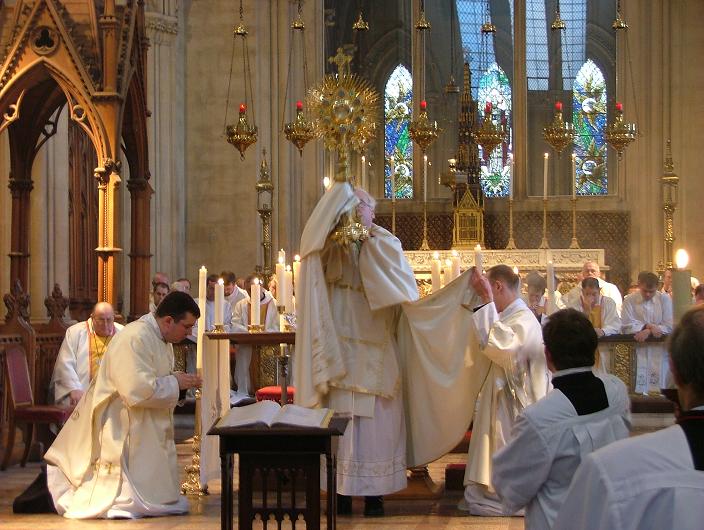If you should attend an Anglo-Catholic Eucharist you would find that it appears (and maybe feels) the same as a Catholic Eucharist.
I should point out that Anglo-Catholics are Anglican Christians who like to do things in a Catholic way. Indeed, they are often “more Catholic than the Catholics” in their commitment to fine liturgy, beautiful buildings, reverent devotions etc. Furthermore, they will claim that they also believe the same thing as Catholics. They pray for the pope, they go on pilgrimages, they venerate the Blessed Virgin, they believe in the “Real Presence.” Go here for an article I wrote some time ago about the term “The Real Presence.”
So what should a Catholic say to an Anglican friend who says the Eucharist in his Anglican Church is “the same” because he feels the same way as he does in the Catholic Church?
Two things: Firstly, the reality of Catholic sacrament is not based on one’s feelings. We believe an objective, real transformation takes place on the altar by the power of God under the hands of the priest. One’s feelings are not what determines the reality of the Eucharistic transformation. It is not surprising that an Anglican says this however, because, while Anglicans disagree among themselves about the Eucharist, the prevailing belief among Anglicans is “receptionism”–that the bread and wine become the Body and Blood of Christ as the individual receives the elements by faith. So, according to the words of the Anglican Book of Common Prayer, as the priest distributes communion he says, “The Body of Our Lord Jesus Christ which was given for you preserve your body and soul unto everlasting life. Take and eat in remembrance that Christ died for you and feed on him in your heart by faith with thanksgiving.”
Analyze those words. They express the Anglican doctrine of receptionism–not that there is an objective transformation at the altar, but that the transformation is dependent on the faith of the recipient.
This is NOT what Catholics believe. Therefore Anglican and Catholic Eucharist is not the same. Catholics believe in transubstantiation–that the substance (the inner reality) of the Bread and Wine are transformed into the Body and Blood of Christ and that this is a real, objective transformation.
Now a particular Anglican may say they believe the Catholic doctrine, but when we move past personal opinions and look at the formal doctrinal statement of the Anglican Church we realize that not only can this be no more than a personal opinion on the part of the Anglican who says he believes the Catholic doctrine, but it also a repudiation of his own religion and therefore (according to the formal doctrinal statements of the Anglican Church) a betrayal of his religion.
To make my point, Anglican priests, at their ordination, have to subscribe to the 39 Articles of Religion. This classic statement of Anglican Doctrine from the 16th century specifically rejects transubstantiation and everything else that is distinctively Catholic (purgatory, seven sacraments, veneration of relics, Eucharistic adoration etc)
Article 28 says:
Transubstantiation (or the change of the substance of Bread and Wine) in the Supper of the Lord, cannot be proved by Holy Writ; but is repugnant to the plain words of Scripture, overthroweth the nature of a Sacrament, and hath given occasion to many superstitions.
The Body of Christ is given, taken, and eaten, in the Supper, only after an heavenly and spiritual manner. And the mean whereby the Body of Christ is received and eaten in the Supper, is Faith.The Sacrament of the Lord’s Supper was not by Christ’s ordinance reserved, carried about, lifted up, or worshipped.
In the nineteenth century St John Henry Newman and his colleagues in the Oxford movement tried very hard to re-interpret the 39 Articles of Religion in a Catholic way.
They were unsuccessful both in their attempt and in their ambition to convince the majority of Anglicans.
Is Anglo-Catholic and Catholic Eucharist “the same”?
It is impossible to think such a thing. At their ordination, Anglican priests must specifically repudiate the Catholic doctrine.
What they do may look and feel very Catholic, but it is a counterfeit, and remember the thing about a counterfeit is, of course, that it looks and feels very like the real thing.
That’s the point of the counterfeit.
In making this judgement we should also affirm that there are many good, prayerful, kind and sincere Anglo Catholics.
There are also many people who cannot tell a fake twenty dollar bill from a real one. Then there are others who actually know the difference between the real and the counterfeit, but continue willfully to not only pass the fake currency, but to print more.







Leave A Comment
You must be logged in to post a comment.